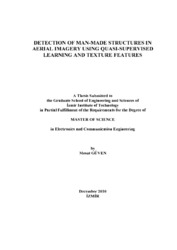Please use this identifier to cite or link to this item:
https://hdl.handle.net/11147/3064Full metadata record
| DC Field | Value | Language |
|---|---|---|
| dc.contributor.advisor | Karaçali, Bilge | - |
| dc.contributor.author | Güven, Mesut | - |
| dc.date.accessioned | 2014-07-22T13:50:49Z | - |
| dc.date.available | 2014-07-22T13:50:49Z | - |
| dc.date.issued | 2010 | - |
| dc.identifier.uri | http://hdl.handle.net/11147/3064 | - |
| dc.description | Thesis (Master)--Izmir Institute of Technology, Electronics and Communication Engineering, Izmir, 2010 | en_US |
| dc.description | Includes bibliographical references (leaves: 59-61) | en_US |
| dc.description | Text in English; Abstract: Turkish and English | en_US |
| dc.description | x, 61 leaves | en_US |
| dc.description.abstract | In this thesis, the quasi-supervised statistical learning algorithm has been applied for texture recognitioning analysis. The main objective of the proposed method is to detect man-made objects or differences on the terrain as a result of habitating. From this point of view, gaining information about human presence in a region of interest using aerial imagery is of vital importance. This task is adressed using a machine learning paradigm in a quasi-supervised learning. Eigthteen different sized aerial images were used in all computations and analysis. The available data was divided into a reference control set which consist of normalcy condition samples with no human presence, and a mixed testing data set which consisting images of habitate and cultivated terrain. Grey level co-occurrence matrices were then computed for each block and .Haralick Features. were extracted and organized into a texture vector. The quasi-supervised learning was then applied to the collection of texture vectors to identify those image blocks which show human presence in the test data set. In the performance evaluatian part, detected abnormal areas were compared with manually labeled data to determine the corresponding reciever operating characteristic curve. The results showed that the quasi-supervised learning algorithm is able to identify the indicators of human presence in a region such as houses, roads and objects that are not likely to be observed in areas free from human habitation. | en_US |
| dc.language.iso | en | en_US |
| dc.publisher | Izmir Institute of Technology | en_US |
| dc.rights | info:eu-repo/semantics/openAccess | en_US |
| dc.subject.lcsh | Supervised learning (Machine learning) | en |
| dc.title | Detection of Man-Made Structures in Aerial Imagery Using Quasi-Supervised Learning and Texture Features | en_US |
| dc.type | Master Thesis | en_US |
| dc.institutionauthor | Güven, Mesut | - |
| dc.department | Thesis (Master)--İzmir Institute of Technology, Electrical and Electronics Engineering | en_US |
| dc.relation.publicationcategory | Tez | en_US |
| dc.identifier.wosquality | N/A | - |
| dc.identifier.scopusquality | N/A | - |
| item.openairecristype | http://purl.org/coar/resource_type/c_18cf | - |
| item.languageiso639-1 | en | - |
| item.openairetype | Master Thesis | - |
| item.grantfulltext | open | - |
| item.fulltext | With Fulltext | - |
| item.cerifentitytype | Publications | - |
| Appears in Collections: | Master Degree / Yüksek Lisans Tezleri | |
Files in This Item:
| File | Description | Size | Format | |
|---|---|---|---|---|
| T000876.pdf | MasterThesis | 5.34 MB | Adobe PDF |  View/Open |
CORE Recommender
Page view(s)
172
checked on Mar 31, 2025
Download(s)
98
checked on Mar 31, 2025
Google ScholarTM
Check
Items in GCRIS Repository are protected by copyright, with all rights reserved, unless otherwise indicated.